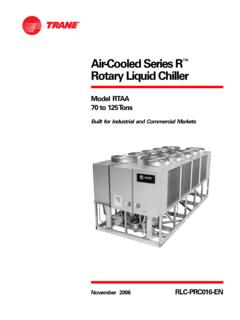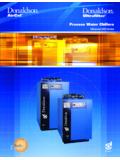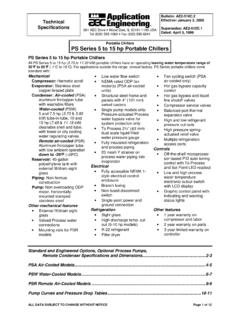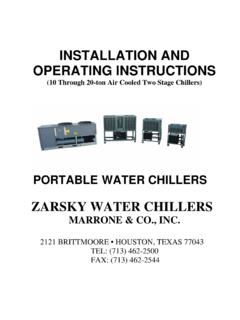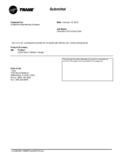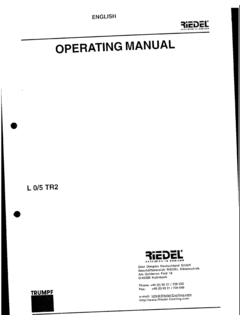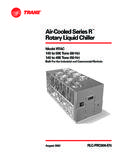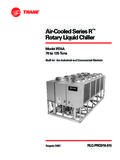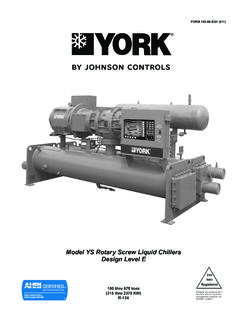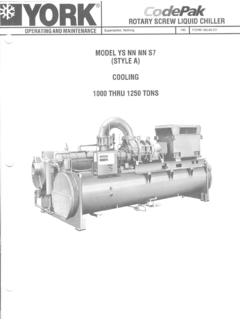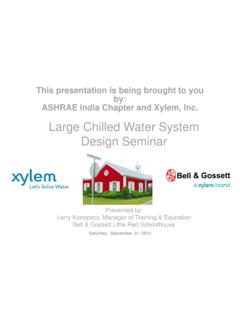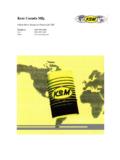Transcription of Installation Operation Maintenance
1 Installation Operation Maintenance Series R . rotary Liquid Chillers Water-Cooled and Condenserless Packaged Water-Cooled Chiller, RTWA 70-125. Water-Cooled Compressor Chiller RTUA 70-125. Air-Cooled Condenser RTCA 70-125. Models RTWA-70 RTUA-70 RTCA-70. RTWA-80 RTUA-80 RTCA-80. RTWA-90 RTUA-90 RTCA-90. RTWA-100 RTUA-100 RTCA-100. RTWA-110 RTUA-110 RTCA-110. RTWA-125 RTUA-125 RTCA-125. October 2005 RLC-SVX07A-EN. American Standard Inc. 2005. NOTICE: Warnings and Cautions appear at appropriate sections through- out this literature. Read these carefully.
2 WARNING: Indicates a potentially hazardous situation which, if not avoided, could result in death or serious injury. CAUTION: Indicates a potentially hazardous situation which, if not avoided, may result in minor or moderate injury. It may also be used to alert against unsafe practices. CAUTION: Indicates a situation that may result in equipment or property- damage only accidents. Important Environmental Concerns! Scientific research has shown that certain man-made chemicals can affect the earth's naturally occurring stratospheric ozone layer when released to the atmosphere.
3 In particular, several of the identified chemicals that may affect the ozone layer are refrigerants that contain Chlorine, Fluorine and Carbon (CFCs) and those containing Hydrogen, Chlorine, Fluorine and Carbon (HCFCs). Not all refrigerants containing these compounds have the same potential impact to the environment. Trane advocates the responsible handling of all refrigerants including industry replacements for CFCs such as and HCFCs and HFCs. Responsible Refrigerant Practices! Trane believes that responsible refrigerant practices are important to the environment, our customers, and the air conditioning industry.
4 All technicians who handle refrigerants must be certified. The Federal Clean Air Act (Section 608) sets forth the requirements for handling, reclaiming, recovering and recycling of certain refrigerants and the equipment that is used in these service procedures. In addition, some states or municipalities may have additional requirements that must also be adhered to for responsible management of refrigerants. Know the applicable laws and follow them. WARNING. Contains Refrigerant! System contains oil and refrigerant under high pressure. Recover refrigerant to relieve pressure before opening the system.
5 See unit nameplate for refrigerant type. Do not use non-approved refrigerants, refrigerant substitutes, or refrigerant additives. Failure to follow proper procedures or the use of non-approved refrigerants, refrigerant substitutes, or refrigerant additives could result in death or serious injury or equipment damage. 2 RLC-SVX07A-EN. Contents General Information .. 5. Unit Identification .. 5. Unit Inspection .. 5. Inspection Checklist .. 5. Loose Parts Inventory .. 5. Unit Description .. 5. Installation Responsibilities .. 9. Nameplates .. 10. Unit Nameplate.
6 10. Model Number Coding System .. 11. Storage .. 14. Installation - Mechanical .. 15. Pre- Installation .. 15. Location Requirements .. 15. Rigging .. 15. Lifting Procedure .. 16. Unit Isolation and Leveling .. 27. Water Piping .. 31. Evaporator Water Piping (for RTWA and RTUA Units Only) .. 31. Condenser Water Piping (for RTWA Units Only) .. 38. Water Regulations Valve (for RTWA Units Only) .. 39. Water Treatment .. 41. Water Pressure Gauges .. 41. Water Pressure Relief Valves .. 41. Field-Installed Water Temperature Sensors .. 41. Water Sensor Installation Procedure.
7 41. Refrigerant Relief Valve Venting .. 42. Initial Leak Test .. 44. Installation - Remote Condenser .. 45. Remote Air-Cooled Condenser Interconnecting Refrigerant Piping .. 45. Installation - Electrical .. 58. Installer-Supplied Components .. 62. Power Supply Wiring .. 62. Interconnecting Wiring .. 62. Low Voltage Wiring .. 67. Optional Bidirectional Communications Link (BCL) .. 75. Remote Clear Language Display Installation Procedure .. 77. Installation Checklist .. 81. Operating Principles .. 83. Refrigeration (Cooling) Cycle .. 85. Oil System Operation (RTWA and RTUA Only).
8 87. Controls Interface .. 91. Clear Language Display Keypad Overview .. 91. Diagnostics .. 112. Operational Features .. 113. DIP Switch Settings .. 120. Pre-Start Checkout .. 122. Unit Voltage Power Supply .. 123. RLC-SVX07A-EN 3. Contents Unit Voltage Imbalance .. 124. Unit Voltage Phasing .. 124. Water System Flow Rates .. 126. Water System Pressure Drop .. 126. Start-Up Procedures .. 127. System Superheat .. 128. System Subcooling .. 128. Unit Shutdown Procedures .. 131. Temporary Shutdown and Restart .. 131. Extended Shutdown Procedure .. 131. System Restart after Extended Shutdown.
9 131. Periodic Maintenance .. 133. Weekly Maintenance .. 133. Monthly Maintenance .. 133. Annual Maintenance .. 133. Maintenance .. 137. Cleaning the Evaporator (RTWA and RTUA) .. 137. Cleaning the Condenser .. 137. Water Treatment .. 139. Oil Separator Level Check .. 139. Refrigerant Charging .. 143. Adding Refrigerant .. 143. Low Side Repairs .. 144. High Side Repair .. 144. Diagnostics .. 146. Unit Wiring .. 155. Unit Wiring .. 155. 4 RLC-SVX07A-EN. General Information Unit Identification When the unit arrives, compare all nameplate data with ordering and shipping information.
10 Unit Inspection When the unit is delivered, verify that it is the correct unit and that it is properly equipped. Compare the information which appears on the unit nameplate with the ordering and submittal information. Refer to Nameplates . Inspect all exterior components for visible damage. Report any apparent damage or material shortage to the carrier and make a unit damage . notation on the carrier's delivery receipt. Specify the extent and type of damage found and notify the appropriate Trane Sales Office. Do not proceed with Installation of a damaged unit without sales office approval.
